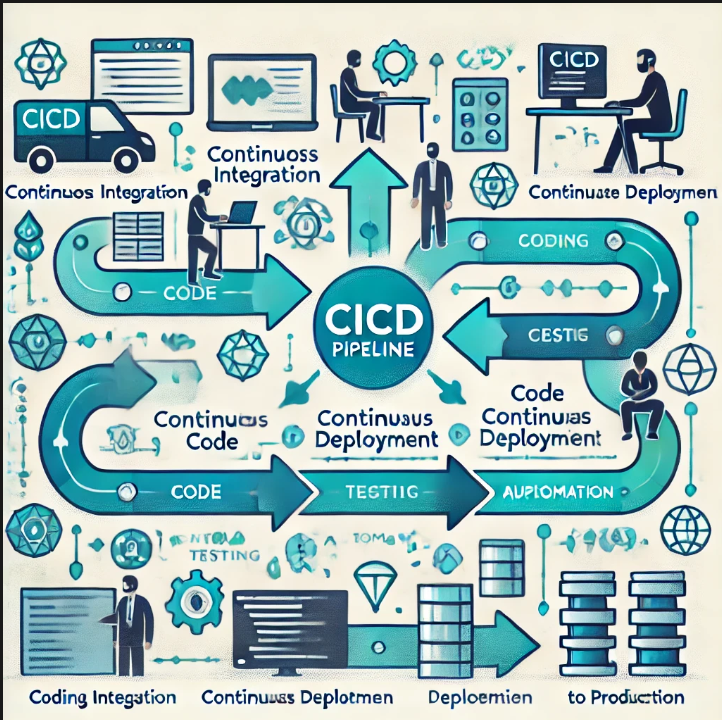 CASE STUDY
CASE STUDY What is CICD? A Complete Guide to Continuous Integration and Continuous Deployment

CICD has become a cornerstone of efficient workflows in the ever-evolving world of software development. Short for Continuous Integration (CI) and Continuous Deployment (CD), CICD enables teams to develop, test, and deploy software faster and with greater reliability. This blog provides a comprehensive look at CICD, focusing on Continuous Integration and Continuous Deployment, and explains why they are essential for modern development practices.
What is CICD?
CICD is a set of practices that streamline the development lifecycle by automating code integration, testing, and deployment. It’s designed to ensure that software can be reliably delivered at any time.
The CICD pipeline is a workflow that integrates Continuous Integration, Continuous Delivery, and Continuous Deployment, helping teams avoid manual bottlenecks and focus on building innovative solutions.
What is Continuous Integration in CICD?
Continuous Integration (CI) is a practice within the CICD pipeline that automates the process of integrating code changes from multiple developers into a single codebase. This ensures that the codebase is always in a deployable state.
How Continuous Integration Works in CICD
- Developers commit code changes frequently to a shared repository.
- Automated build tools compile the code, checking for errors.
- Automated tests run to validate the functionality of the new code.
Benefits of Continuous Integration in CICD
- Faster Feedback: Developers receive immediate feedback on their changes.
- Reduced Integration Conflicts: Frequent integrations reduce merge conflicts.
- Improved Code Quality: Automated testing ensures code is reliable and functional.
By incorporating Continuous Integration into your CICD pipeline, you can catch errors early and streamline the development process.
What is Continuous Deployment in CICD?
Continuous Deployment (CD) is the practice of automatically pushing code changes to production once they pass all tests. It eliminates the need for manual deployment processes, allowing teams to deliver features and fixes faster.
How Continuous Deployment Works in CICD
- Code changes validated by Continuous Integration are automatically deployed.
- Deployment tools push the changes to production servers.
- Monitoring systems ensure deployments are successful and perform rollback if issues occur.
Benefits of Continuous Deployment in CICD
- Faster Delivery: Features and updates reach users immediately.
- Reduced Manual Errors: Automation reduces deployment risks.
- Enhanced Agility: Teams can respond to user feedback quickly.
With Continuous Deployment, your CICD pipeline becomes a powerful tool for maintaining a competitive edge.
The Importance of CICD in Modern Development
Implementing a CICD pipeline brings significant advantages to any development team:
- Efficiency: Automation reduces manual tasks, allowing developers to focus on innovation.
- Quality Assurance: Frequent testing ensures high-quality code is delivered.
- Faster Time to Market: Automated workflows enable rapid feature releases.
- Collaboration: Developers work in smaller, manageable batches, minimizing conflicts.
By adopting CICD, organizations can create a seamless, reliable, and scalable development process.
Key Differences Between Continuous Integration and Continuous Deployment in CICD
Why CICD is Critical for Software Teams
Modern software demands agility, speed, and quality. CICD enables teams to meet these demands by:
- Reducing downtime through automated processes.
- Delivering features faster, keeping users engaged.
- Ensuring robust, tested code reaches production.
By implementing Continuous Integration and Continuous Deployment, your CICD pipeline can transform your development workflow.
Conclusion: Harness the Power of CICD
CICD is more than just a workflow; it’s a mindset that drives innovation and efficiency. With Continuous Integration ensuring stable codebases and Continuous Deployment delivering seamless updates, your team can achieve unparalleled productivity.
Whether you’re building web applications, mobile apps, or enterprise software, incorporating CICD practices is essential for staying competitive in today’s fast-paced development landscape.
Invest in your CICD pipeline today, and watch your development process evolve to the next level.
